Please Take Note: This is a review of the final game, but it might change slightly based on the success of the Kickstarter campaign. The game is being reviewed on the components and the rules provided with the understanding that “what you see is not what you might get” when the game is published. If you like what you read and want to learn more, we encourage you to visit the Kickstarter campaign. Now that we have all that disclaimer junk out of the way, on with the review.
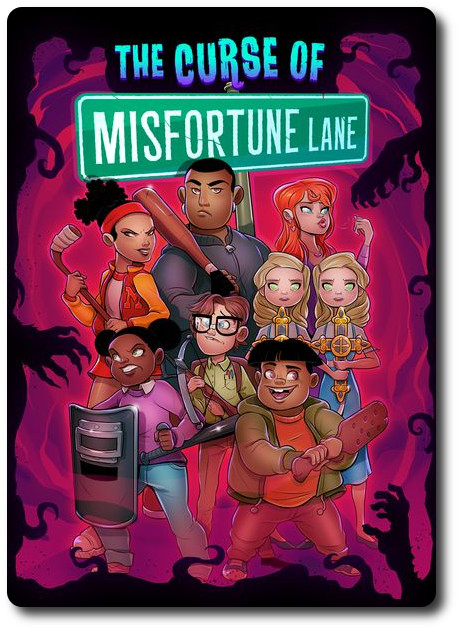
The Basics:
- For ages 10 and up (publisher suggests 14+)
- For 2 to 5 players
- Approximately 30 minutes to complete
Geek Skills:
- Active Listening & Communication
- Counting & Math
- Logical & Critical Decision Making
- Reading
- Strategy & Tactics
- Risk vs. Reward
- Cooperative & Team Play
- Hand/Resource Management
- Bluffing and Misdirection
Learning Curve:
- Child – Easy
- Adult – Easy
Theme & Narrative:
- Break the town’s curse once and for all or be forever part of its dark history
Endorsements:
- Gamer Geek approved!
- Parent Geek approved!
- Child Geek approved!
Overview
Every town has its secrets. Its dark past. Your town is no different. Except for one very important detail. Every 13th of Friday, a curse is let loose that brings nightmares to all who live on Misfortune Lane. No more. You and your friends at school have decided to break this curse. But being a kid that no adults listen to, what can you do? Not much, perhaps, and the monster in the shadows is counting on it!
The Curse of Misfortune Lane, designed by Alexander Delfino, Austin Mace and to be published by Howling Hog Games, will reportedly be comprised of 8 Location Panel cards, 7 Kid Character cards, 3 Monster Character cards, 55 Location cards, and 30 Monster cards. As this is a review of a prepublished game, I cannot comment on the game component quality. Artist Dave Collinson has inked colorful artwork on the cards that depict the different characters in the game, providing the players a more indepth narrative and thematic experience.
Thursday the 12th
To set up the game, first take the eight Location Panel cards and place them in a row in the middle of the playing area. The order in which they are placed is not important to game play.
Second, take the Location cards and distribute them to their corresponding Location Panel card, creating piles. Take each pile of cards and shuffle, placing the deck of shuffled cards face-down underneath its corresponding Location Panel card to create the Location decks.
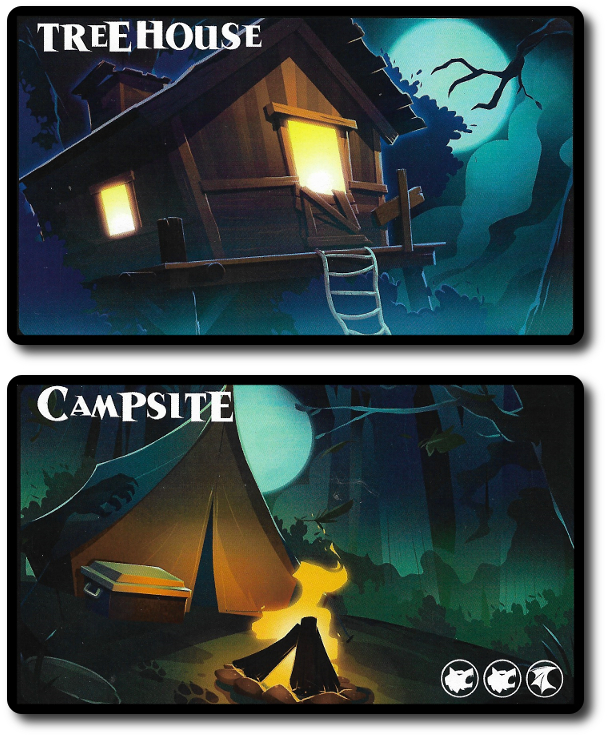
Third, decide who will be the “Monster” for the game. The Monster player takes the Monster Character cards and selects one, keeping their selected Monster Character card a secret.

All other players will be the “Kids”. The Kid players take the Kid Character cards, select one, and place it in front of them, face-up. Place all unselected Monster and Kid Character cards back in the game box.
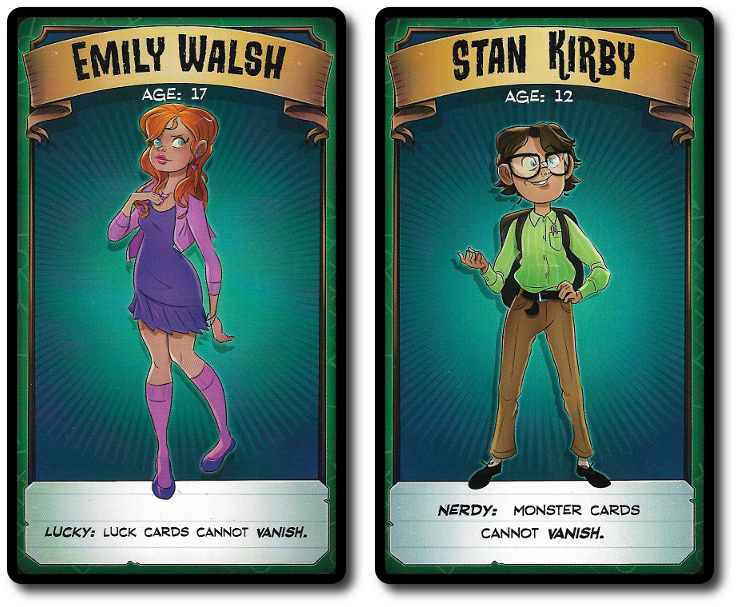
Fourth, the Monster player takes all the Monster cards with the “Day” symbol (looks like a sun) to create their “Stash”, which is the Monster player’s initial inventory. At this time, the Monster player takes their two “Ladder” Monster cards and places them on two different Location decks.
Fifth, place all other cards to the side of the game playing area. They will be used, but not until the Night phase of the game.
That’s it for game set up. Time to see if the curse can be broken!
Friday the 13th
The Curse of Misfortune Lane is played in phases, rounds, steps, and turns. The first half of the game is played during the “Day” phase, wherein the Kids go about finding as much information as they can to tackle the monster at night. During the “Night” phase, the monster becomes stronger and takes more direct action. Each of the phases, the rounds, steps, and turns are summarized here.
 The Day Phase
The Day Phase
The Day phase consists of six rounds. The number of rounds left in the Day phase can be tracked by the number of “Day” Monster cards the Monster player has remaining. Each Day phase has the following steps that are completed in the listed sequential order. Kid players take their turns based on the age listed on their Kid Character card, with the oldest Kid going first, followed by the next oldest and so on.
Step One: Influence
During game set up, the Monster player places two “Ladder” Monster cards. These are meant to hinder the Kid players during their investigation. For the first round of the Day phase, the Monster places no additional cards from their hand. After the first round, the Monster player will place one Monster card in their hand to any of the Location decks after the Investigation step.
The trick here is that the Monster player is attempting to keep their identity hidden (which is somewhat suggested by the icons on the Location cards), while at the same time trying to weaken the Location deck that will harm them the most. This is something of a shell game, as the Monster player wants to keep the Kid players guessing with fake information, while at the same time providing real information about their selected monster’s weakness (which they are forced to do, but not in a way that is obvious).
Step Two: Investigate
Starting with the oldest Kid player and continuing in age order sequence, each Kid player searches one Location. Searching means the player draws and reveals the top-most card. If the card is an “Encounter”, it’s resolved right away per the instructions on the card. If it’s not an Encounter, the Location card is placed in the active Kid player’s hand. Cards held by the Kid players during the round are referred to as “Inventory”. These are all temporary and might be available to the Kid players during the Night phase if they don’t lose them first.
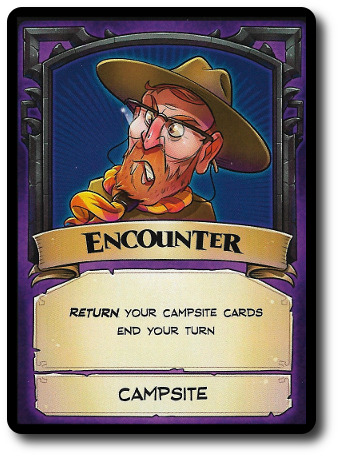
Adults are not helpful in this game…
The active Kid player can decide to end their turn here if they did not draw an Encounter and let the next Kid player go or they can press their luck. If the player does decide to press their luck, they draw another card from the same location. This can be repeated as many times as the player likes. The player is welcome to stop at anytime or forced to stop when they draw an Encounter.
Step Three: Deposit
Each Kid player must now place all cards in their Inventory into the Treehouse deck. Cards placed in the Treehouse are protected, but are not available until the Night phase. Cards stored in the Treehouse deck are very useful, and to a certain degree, the Kid players are thematically fortifying themselves for the night to come. Mechanically speaking from a game standpoint, the Kid players are building their deck. This point must be clearly understood as it influences the next step.
Step Four: Discuss
While the Day phase has a maximum of six rounds, the game need not take that many. The Kid players must now decide if they want to continue their investigation (which means the Monster player can continue to cause mischief) or skip to the Night phase.
Let’s understand what this choice really means…
As the Kid players take their turn during the Day phase, they build their deck and try to determine the monster type the Monster player is playing as. Continuing to investigate will certainly allow the Kid players to get more information, but it also means they will be filling their Treehouse deck with possible junk and unhelpful cards until such time they get a better idea of what the threat is.
And herein lies the question the Kid players must answer…
Do they stop now and go right to the Night phase because they feel they know what the monster is and their Treehouse deck is optimized for the encounter? Or do they keep searching during the Day phase because they might not know what the Monster player is or might not feel they have a good Treehouse deck?
Ah, but there is a catch. The Kid players must vote. If the vote is not unanimous to enter the Night phase, the Day phase continues. If the Day phase does continue, repeat step one noted above. If not, enter the Night phase.
 The Night Phase
The Night Phase
There is a bit of set up for the night phase. First, the Monster player reveals which monster they are to the Kid players and rebuilds their Monster stash by using all the Monster cards with the night symbol (looks like a moon). In addition, the Monster player adds the four Monster cards with all the Zombie, Vampire, and Werewolf symbols included on a single card. Then all the cards on the table are removed from the game, except those in the Treehouse location, the Treehouse deck (created by the Kid players), the Monster Character card (now revealed), the Kid Character cards, the Monster’s stash, and the Monster Health card, which is now placed under the revealed Monster Character card. The monster’s starting health is based on the number of Kid players. The more Kid players there are, the stronger the monster.
The Treehouse encounter cards are placed into the Treehouse deck according to the number of cards in the deck itself. For example, if there are one to 12 cards, then zero encounters will be added. However, if there are 39 or more cards, three encounters will be added. See now why it’s important to keep the Treehouse deck as thin as possible? Shuffle the Treehouse deck when done.
The Night phase is seven rounds of game play. Each round, like the Day phase, is comprised of steps and turns. Unlike the Day phase, the Night phase lasts all seven rounds and cannot be ended prematurely with a vote. In addition, each Kid Character card has a special ability that can be triggered, but only during the Night phase.
Step One: Passive Influence
The newly revealed Monster Character card will list a special ability. This is now triggered by the Monster player and must be resolved before the Investigate step.
Step Two: Investigate
This step is the same one taken during the Day phase, but with two small changes. There is only one Location deck to search (the Treehouse) and an encounter might force all Kid players to discard their inventory! The only good news here regarding the encounter is that it allows the Kid players to shuffle all the cards in their discard pile back into the Treehouse deck.
Step Three: Active Influence
This step is the same as the Day “Influence” step.
Step Four: Confront!
The Kid players now combine their inventory to determine how much damage they deal to the Monster player.
- For each seven points of Luck, the Monster player takes one point of health damage
- For each relevant monster weapon (i.e. it matches the Monster Character card in play), the Monster player takes one point of damage
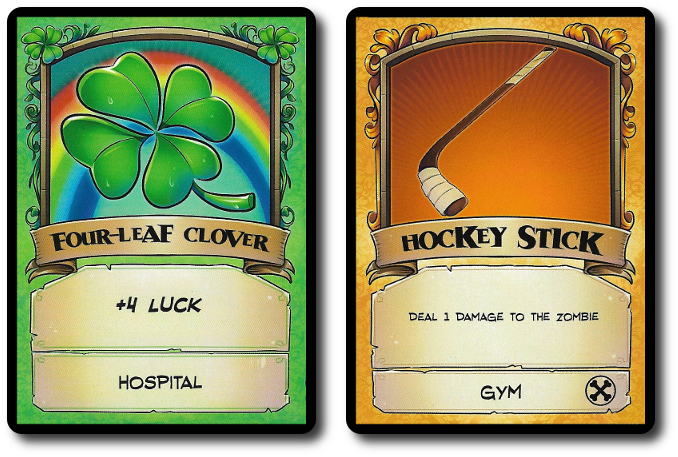
Luck always works, but the hockey stick is particularly good against zombies
Keep in mind that the Monster player could have cards in the inventory that could help them. Reduce Luck as needed!
After determining how much, if any, damage is dealt, all the Kid players discard their inventory to a single discard pile, the Monster player adjusts their Monster’s health, and game play continues as noted above for the next round.
Breaking the Curse or Falling Victim to It
If the Monster player is able to survive to the end of the seventh round, they win! If not, the Kid players have won and have broken the curse!
Game Variant
While The Curse of Misfortune Lane plays excellently with a group, it can also be played by only two people. Although, in my opinion, it’s not as fun. Have one player take on the role of the monster and the other player take on the role of two Kids of their choice. The two-player rules have changed for the final game since we played it, so I am hesitant to speak to it in any great detail here.
To learn more about The Curse of Misfortune Lane, visit the Kickstarter campaign.
Final Word
 The Child Geeks quickly learned how to play the game. The Curse of Misfortune Lane is light when it comes to rules and puts the majority of the game in the player’s lap to determine how best to approach the objectives. The Child Geeks liked this a great deal, as the game rules provided structure and maneuverability. According to one Child Geek, “When I played with my friends, we really felt like we were a monster hunting team!” Another Child Geek said, “I liked playing as the monster, but it is a bit lonely. I liked it better when I was able to play as myself [sic].” And by “myself”, the Child Geek was suggesting that being a kid and playing as a kid in this game was a great time. So much so that all the Child Geeks agreed, voting to fully endorse The Curse of Misfortune Lane.
The Child Geeks quickly learned how to play the game. The Curse of Misfortune Lane is light when it comes to rules and puts the majority of the game in the player’s lap to determine how best to approach the objectives. The Child Geeks liked this a great deal, as the game rules provided structure and maneuverability. According to one Child Geek, “When I played with my friends, we really felt like we were a monster hunting team!” Another Child Geek said, “I liked playing as the monster, but it is a bit lonely. I liked it better when I was able to play as myself [sic].” And by “myself”, the Child Geek was suggesting that being a kid and playing as a kid in this game was a great time. So much so that all the Child Geeks agreed, voting to fully endorse The Curse of Misfortune Lane.
 The Parent Geeks really enjoyed the game, as well. They mostly had to take on the role of the monster, which they felt – at times – put them at a disadvantage. According to one Parent Geek, “I get why my kids want me to play as the monster, but I often feel like I should go easy on them because – well – I’m their mom.” This might be the case (actually, I’m sure the person is the children’s mom), but the game designers anticipated this type of approach by the players. The Monster player is forced to play cards. What card they play is totally up to the Monster player, but the fact that the monster is always active and in the shadows means that the Kid players, regardless of how empathetic the Monster player might be, is always a danger. According to another Parent Geek, “A great game to play with the family and friends. I don’t mind playing as the monster and love how much fun I have when I get to play as a kid with the kids.” When all the votes were in, both monster and kid Parent Geeks agreed that The Curse of Misfortune Lane was a winner.
The Parent Geeks really enjoyed the game, as well. They mostly had to take on the role of the monster, which they felt – at times – put them at a disadvantage. According to one Parent Geek, “I get why my kids want me to play as the monster, but I often feel like I should go easy on them because – well – I’m their mom.” This might be the case (actually, I’m sure the person is the children’s mom), but the game designers anticipated this type of approach by the players. The Monster player is forced to play cards. What card they play is totally up to the Monster player, but the fact that the monster is always active and in the shadows means that the Kid players, regardless of how empathetic the Monster player might be, is always a danger. According to another Parent Geek, “A great game to play with the family and friends. I don’t mind playing as the monster and love how much fun I have when I get to play as a kid with the kids.” When all the votes were in, both monster and kid Parent Geeks agreed that The Curse of Misfortune Lane was a winner.
 The Gamer Geeks were a bit confused at first as to why the game was so light in the rules department. According to one Gamer Geek before the game started, “I think this game is going to suffer from the fact that it is not nearly clear enough on how the game should be balanced between the monster and kid players.” After two games, they said, “Wow, I was wrong.” The Gamer Geeks enjoyed the game, finding the rules to be easy to follow and to the point, without leaving room for interpretation due to ambiguity. As one Gamer Geek put it, “The game designers did a great job of letting the game’s theme and narrative direct game play, providing just enough rules to keep the game ordered.” To put it another way, the game felt light to the Gamer Geeks, but the game play was just as intense as you’d expect from a larger game. This greatly pleased the Gamer Geeks who all agreed to endorse The Curse of Misfortune Lane.
The Gamer Geeks were a bit confused at first as to why the game was so light in the rules department. According to one Gamer Geek before the game started, “I think this game is going to suffer from the fact that it is not nearly clear enough on how the game should be balanced between the monster and kid players.” After two games, they said, “Wow, I was wrong.” The Gamer Geeks enjoyed the game, finding the rules to be easy to follow and to the point, without leaving room for interpretation due to ambiguity. As one Gamer Geek put it, “The game designers did a great job of letting the game’s theme and narrative direct game play, providing just enough rules to keep the game ordered.” To put it another way, the game felt light to the Gamer Geeks, but the game play was just as intense as you’d expect from a larger game. This greatly pleased the Gamer Geeks who all agreed to endorse The Curse of Misfortune Lane.
 Now here is a game a player can really get into. It requires tactics, strategy, team work, deception, and negotiation. There are surprises at every corner, risks to be taken, and rewards that equal the severity of the risks. The game feels very balanced, while at the same time offering the players a feeling of apprehension and mystery, regardless of their role.
Now here is a game a player can really get into. It requires tactics, strategy, team work, deception, and negotiation. There are surprises at every corner, risks to be taken, and rewards that equal the severity of the risks. The game feels very balanced, while at the same time offering the players a feeling of apprehension and mystery, regardless of their role.
The game is very indifferent and passive in its approach. It’s not weighted towards the kids or the monster. It’s the players who bring the aggression to the table and victory goes to the craftiest. The rules in place provide the road. The players can go off into the weeds and decide how fast to travel on it based on what they believe is the best approach to win. The game just shrugs, says “whatever”, and keeps going without so much as the slightest hiccup.
The Curse of Misfortune Lane appears to be, to some degree, influenced by such great movies as It, The Monster Squad, Coraline, and even Monster House. If that is the case, I love this game even more. Stories where kids are pitted against a monster are always interesting, as the kids in the movie have to face a great threat with no adult help. Which is exactly the kind of thing that is really horrifying to a kid (and even to an adult). The game gives off a strong vibe that the Kid players are all on their own and the Monster player knows it. This makes The Curse of Misfortune Lane not only feel very thematic, but the game play is further reinforced by the fact that the Kid players and the Monster player both have one hand tied behind their back. The Kid players have to rally to their own aid and the Monster player has to keep hidden so as to not draw attention to themselves.
Great stuff.
Do play this game when time allows. Perfect, I believe, for both casual and more elite gamers. Great as a filler, for a night of mystery, and whenever you want to take on a curse as a team.
This is a paid for review of the game’s final prototype. Although our time and focus was financially compensated, our words are our own. We’d need at least 10 million dollars before we started saying what other people wanted. Such is the statuesque and legendary integrity of Father Geek which cannot be bought except by those who own their own private islands and small countries.



